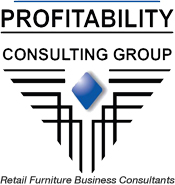When John Egger founded our company he christened it “Profitability Consulting Group “ (PCG) for a reason . While we believe and preach sustainable sales growth , growth without profit and positive cash flow can be disastrous. This was exactly what we encountered when we received a call from a prospective client in 2015.
Our Preparation
As is our practice , we began the engagement by reviewing our 25 page questionnaire that we asked the client to complete to the best of their ability. We also reviewed current and prior year financials as well as key merchandise and inventory reports. It is our protocol to know as much as possible about a client’s operation PRIOR to our initial on-site visit.
What We Found
When we arrived we met an owner who was beloved by most of the employees , but had allowed the business to grow rapidly without structure , processes or controls. Two stores were generating $17 million a year in revenues , but the company was losing $500,000 – $600,000 a year and burning through cash at an alarming rate. Margins were 7-8 points below where they needed to be to achieve profitability as the sales people were allowed to give away the store to save every sale. Discounting was rampant , and salespeople were free to cut Protection pricing , waive Delivery charges and offer long-term interest-free financing whenever they deemed it necessary. The sales people were making a fortune , as were the suppliers , and the customers were crowing about the great deals they were getting. Payroll and headcounts had skyrocketed as ownership kept throwing bodies at the problem. They were only still solvent because the family owned the business real estate. To make matters even worse , they had recently taken out a hard-money loan to stay afloat , which in our experience is almost always a prelude to bankruptcy. At PCG we view our role is to “keep businesses in business “, not facilitate a GOB sale.
Our Solutions
- Sequenced our holistic approach to the problem which focused on operational , organizational , financial , sales training and merchandising issues.
- Reviewed our plan with their local banker and persuaded him to lend on the one uncollateralized building they owned , with the loan proceeds earmarked to pay off the hard money loan and provide some short-term working capital.
- Raised margins 8-10% , knowing that this would potentially hurt volume in the short run , but was necessary to save the business in the long run.
- Created a new commission program that paid each salesperson on the final realized net margin of the sale , after deducting costs of merchandise and financing , and adding revenue from Protection and Delivery . The salespeople could still give away the store but wouldn’t get paid for the sale if they did. Guess what ? : they stopped almost immediately.
- Re-structured and right-sized the organization to cost-effectively support what we estimated to be the new sales base. Put in a wage freeze and reduced certain salaries that had escalated every year for 10-20 years. Guess how many of those affected by the wage reductions left for other jobs ? : no one. We also identified disruptive employees who we determined were working to undermine our initiatives and against the betterment of the company. With ownership approval we had them terminated from the organization , including one family member whom we actually banned from entering the premises.
- Once we had stabilized the financial situation we turned our Sales Management , Sales Training , Design Theory and In-Home Selling team loose . The programs we instituted gave the Sales Force new skills , confidence and credibility. They now emphasized value , not just price , and further increased margins , close rates and average tickets , as did our Merchandising programs and processes.
- Revamped the Customer Service department and practices in order to resolve what had been an onslaught of customer complaints.
- Instituted weekly structured Management Meetings along with enhanced communication and leadership skills.
- The PCG team members made multiple follow-up visits over several months to ensure that implementation had become institutionalized and a permanent part of the organizational processes , practices and culture.
The Results
- Sales initially decreased by 20% , as we anticipated, but within 3-4 months the increased margins, reduced overhead and payoff of the hard money loan had restored the company to a cash flow neutral/positive position.
- In the first full year following our involvement the company achieved profits of over $600,000 , the owners were delighted and credited PCG with saving the company and helping make a major difference in their lives.
- Today revenues and profits are setting company records and the owners are able to take extended vacations without constantly worrying about the business.
Sometimes bigger is better , but not always.


